|
|

|
Porsche, and the Porsche crest are registered trademarks of Dr. Ing. h.c. F. Porsche AG.
This site is not affiliated with Porsche in any way. Its only purpose is to provide an online forum for car enthusiasts. All other trademarks are property of their respective owners. |
|
|
  |
| JamesM |
 Nov 7 2021, 11:19 PM Nov 7 2021, 11:19 PM
Post
#21
|
|
Advanced Member     Group: Members Posts: 2,103 Joined: 6-April 06 From: Kearns, UT Member No.: 5,834 Region Association: Intermountain Region |
I must admit I'm not 100% sure of the relationship between the AFR and VE table. I probably should do some research on the forums, but here's what it says in Tuner Studio: Including the AFR target with the speed-density, alpha-N, ITB or map/baro algorithms, this allows the VE table to be a 'real' VE table and the desired AFR to be specified in the AFR table. With AFR not included, the AFR table is for reference only and the 'VE' table takes full control. With the MAF algorithm, this MUST be enabled to factor the target AFR into the fuel equation. Note that this function does not require or use feedback from an O2 sensor. That last sentence has me a bit confused. Does that only apply to MAF? (For reference, I'm running speed density. I updated my first post above to reflect that, as that's kind of important to know.) So if you are talking about the setting I think you are talking about, the difference between the "incorporate AFR target" setting being enabled or disabled is best explained by showing exactly what it is doing The basic fuel equation is: PW = ReqFuel * VE(rpm,map) * MAP * GammaE With incorporate AFR it becomes: PW = ReqFuel * VE(rpm,map) * MAP * stoich / targetAFR(rpm,map) * GammaE So... thats the math behind it, but why? Basically the idea behind it is that IF you had your VE tabled tuned so that they produced exactly the AFRs represented in your AFR table you could then enable the "incorporate AFR target" setting, at which point you could in theory just update the AFR values on the AFR table to change your tune. ...in theory its a feature that requires a lot of prep work in that you have to have your VE table tuned to your AFR table perfectly before even enabling it for its function to make any sense. You absolutely dont want it enabled when initially tuning your VE table or you will cause yourself unnecessary headaches. I just leave "incorporate AFR targets" disabled all the time. That is not the only function of the AFR target table though as it is also used for the closed loop wideband O2 correction(if enabled) and with tunerstudios autotune. |
| JamesM |
 Nov 8 2021, 12:26 AM Nov 8 2021, 12:26 AM
Post
#22
|
|
Advanced Member     Group: Members Posts: 2,103 Joined: 6-April 06 From: Kearns, UT Member No.: 5,834 Region Association: Intermountain Region |
Loved it. Car ran flawlessly and the engine was a smooooooooooth as I've ever experienced it. No stumbles, no faults, ran cool on CHT and oil, just an absolute pleasure. 27.5 mpg average on 89 pump gas. But of course, with no radio (by choice) I had a lot of time to think about my tuning as I was tootling down the parkways and interstates, watching the Android tablet display of engine parameters...it runs good, and it sounds good, and it feels good, but...is it actually good? In some cases it may be a bit subjective, I guess we should start by asking... What is your measure of "actually good"? Power? Fuel Economy? Not Blowing Up? Emissions? Something else? I mean it sounds like you are at least fairly happy with it. I guess the blessing (and maybe the curse) of something like this is that there is almost always room for additional refinement and tweaking though. Its hard to say without riding in/driving the car or at least looking at some datalogs if something is obviously out of whack, but if you are happy with it and it isnt blowing up, that seems pretty good. Just glancing at your AFR targets and timing map though I would guess you have both a little power and fuel economy still on the table, but optimizing it is going to be a lot of trial and error, and fully optimizing it will probably need additional instrumentation. |
| BeatNavy |
 Nov 8 2021, 06:43 AM Nov 8 2021, 06:43 AM
Post
#23
|
|
Certified Professional Scapegoat     Group: Members Posts: 2,954 Joined: 26-February 14 From: Easton, MD Member No.: 17,042 Region Association: MidAtlantic Region 
|
So if you are talking about the setting I think you are talking about, the difference between the "incorporate AFR target" setting being enabled or disabled is best explained by showing exactly what it is doing The basic fuel equation is: PW = ReqFuel * VE(rpm,map) * MAP * GammaE With incorporate AFR it becomes: PW = ReqFuel * VE(rpm,map) * MAP * stoich / targetAFR(rpm,map) * GammaE So... thats the math behind it, but why? Basically the idea behind it is that IF you had your VE tabled tuned so that they produced exactly the AFRs represented in your AFR table you could then enable the "incorporate AFR target" setting, at which point you could in theory just update the AFR values on the AFR table to change your tune. ...in theory I just leave "incorporate AFR targets" disabled all the time. That is not the only function of the AFR target table though as it is also used for the closed loop wideband O2 correction(if enabled) and with tunerstudios autotune. James, thanks for helping out and sharing so much experience with us. It's amazing how deep this can get, and it does seem one can spend years trying to learn it, and many minutes hours trying to explain it. Uh, I'm also glad to see, based on your response, that at least I didn't completely step in it (IMG:style_emoticons/default/biggrin.gif) That equation makes perfect sense. I had to look up "GammaE," but I guess it's the combination of any other enrichment factors currently enabled, correct (e.g., warmup, accel enrichment, etc.)? So really ALL the AFR table is doing is changing the pulse width by the factor of dividing stoich (14.7 for pump gas) by the target AFR (e.g., 13.9). So in this example pulse width would be modified by a factor of 14.7/13.9, or roughly 1.05, all other enrichments being the same. Curious why you wouldn't use it? Is it because you are more comfortable with manipulating the VE table directly at this point? Greg, I incorporated fuel cutoff similar to your specs and took her out for a spin yesterday. I like the change. We'll see if it increases efficiency, but I'm going to run with it for a while. I do recall that D-Jet incorporated a fuel cutoff logic on one or more model years (maybe '73?), but then discontinued it. IIRC the thinking was that it somehow impacted emissions negatively by introducing more variation into piston temps. Or something. I also bumped my total advance back up toward 33 degrees, but guess what, I started getting pre-ignition under hard acceleration again. So I backed it down to 30, and it seems better there. Here's the actual Megalog histogram (that I've never really used before) of my drive. Darker green is where I spend most of the time, I guess. 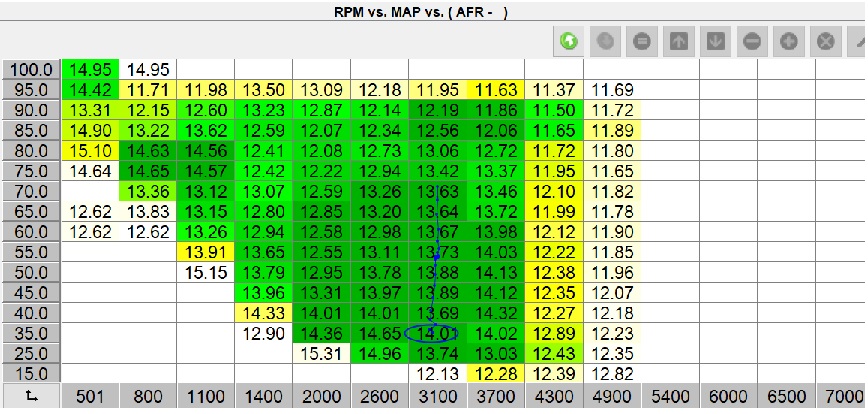 |
| GregAmy |
 Nov 8 2021, 07:40 AM Nov 8 2021, 07:40 AM
Post
#24
|
|
Advanced Member     Group: Members Posts: 2,510 Joined: 22-February 13 From: Middletown CT Member No.: 15,565 Region Association: North East States 
|
In some cases it may be a bit subjective, I guess we should start by asking...What is your measure of "actually good"?
Drivability. Reasonable power (it is, after all, a 75-yr-old engine design). Certainly some reasonable level of fuel economy. My tuning standard is that I want my Honda-driving brother-in-law to be able to jump into the car, fire it up foot-off, and after figuring out where first gear is drive away slowly (I'd coach him being easy on it the first couple miles) and not complain how it drives. Smooth, no choking, no burps. You know, like his Honda. I want him to be able to come back with the car, complain about first gear (they all do), and go "yeah, it drives OK, whatever." It took a bit but I *think* I'm close right now. I still need to work on my sub-60-degrees ambient cold tuning, but I'm pretty solid in 70s-plus. Power? Fuel Economy? Not Blowing Up? Emissions? Something else? I'm not going for outright power, that's not the car's mission; I have the race car for that. But I want the option to be able to take it to a Track Night in America and enjoy an afternoon of 20-minute lapping sessions without worrying about blowin 'er up. I AM NOT convinced I've got that, as I haven't really played out there. Fuel economy and efficiency is certainly a plus, but given the low miles it's being driven anually a 1-2 mpg difference will have neglible financial value. Given I averaged 27-28 highway on this last trip I can't think I could be greedy and ask for more, but I certainly wouldn't reject it, as long as it doesn't compromise driveability. Emissions is not really a consideration, for the same reasons as fuel economy. But I'd not kick it out of the bed. I am reasonably happy with it within the range of driving that I have been doing. But, as Rob, illustrated above, that's a narrow range and nowhere near pushing the edge where I could potentially cause damage (and/or have poor driveability.) So I'd like to have a better concept of where I should be at these extremes to where I can feel safe to tune out there, either at a dyno or during a track lapping day. But within the current driving ranges, I'd be hard-pressed to justify any significant changes. Here to learn... - GA |
| falcor75 |
 Nov 8 2021, 11:01 AM Nov 8 2021, 11:01 AM
Post
#25
|
|
Senior Member    Group: Members Posts: 1,579 Joined: 22-November 12 From: Sweden Member No.: 15,176 Region Association: Scandinavia 
|
I dont run MS on my car but I figured I could post my tables and maybe there is something someone can learn from them. My engine is a 2256 cc, 10.3:1 compression running 40 mm ITB's so the table setup is reflecting that with Alpha-N and its running in wasted spark.
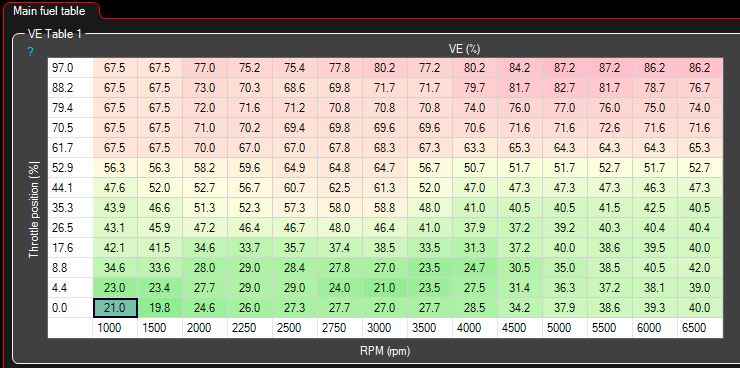 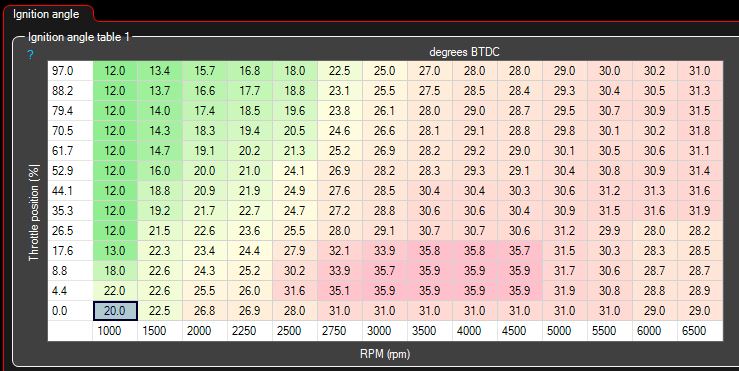 The darker pink area in the ignition table is basically my cruise settings. Its usually done between 12-15% throttle opening. Cruise CHT temps is in the 280-330 range with cyl 1 being the hottest one and always 25-30 F higher than the others. 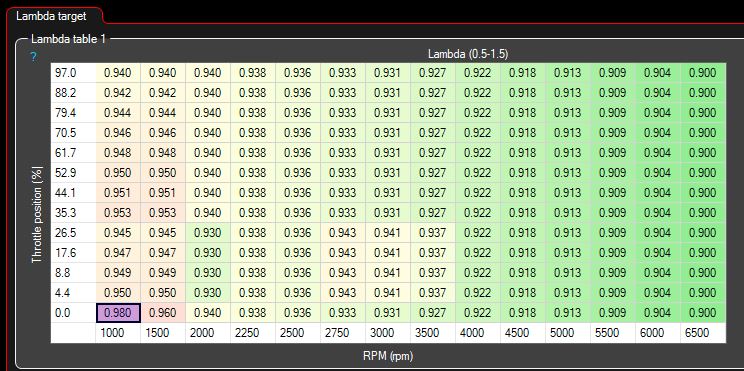 I have a friend thats tuned it for me and the priorities was. 1. Safety (never lean, no detonation etc) 2. Driveability (wide torque range) 3. Power (connected to the above) 4. Milage 5. Emissions (only measured every two years and at idle) |
| JamesM |
 Nov 8 2021, 01:23 PM Nov 8 2021, 01:23 PM
Post
#26
|
|
Advanced Member     Group: Members Posts: 2,103 Joined: 6-April 06 From: Kearns, UT Member No.: 5,834 Region Association: Intermountain Region |
I dont run MS on my car but I figured I could post my tables and maybe there is something someone can learn from them. My engine is a 2256 cc, 10.3:1 compression running 40 mm ITB's so the table setup is reflecting that with Alpha-N and its running in wasted spark.  I dont know about learning anything, but I can tell from your fuel map that your cam sure isnt stock!!! And I thought my motor was a screamer, that thing must be tons of fun once you hit 4k RPMs Are the 40mm TBs large enough to feed that thing? I tuned a 2270 with a milder cam and some smaller (i think 42mm) Jenvy ITBs and I could see a noticeable intake restriction in the datalogs. could have been his tiny air filters though. |
| falcor75 |
 Nov 8 2021, 01:50 PM Nov 8 2021, 01:50 PM
Post
#27
|
|
Senior Member    Group: Members Posts: 1,579 Joined: 22-November 12 From: Sweden Member No.: 15,176 Region Association: Scandinavia 
|
I dont run MS on my car but I figured I could post my tables and maybe there is something someone can learn from them. My engine is a 2256 cc, 10.3:1 compression running 40 mm ITB's so the table setup is reflecting that with Alpha-N and its running in wasted spark.  I dont know about learning anything, but I can tell from your fuel map that your cam sure isnt stock!!! And I thought my motor was a screamer, that thing must be tons of fun once you hit 4k RPMs Are the 40mm TBs large enough to feed that thing? I tuned a 2270 with a milder cam and some smaller (i think 42mm) Jenvy ITBs and I could see a noticeable intake restriction in the datalogs. could have been his tiny air filters though. Correct, its got a web 86 b/c cam. I wasnt sure what size ITB to get when I built the engine so I erred on the smaller side to keep the air/fuel velocity up to aid the low end. |
| GregAmy |
 Nov 8 2021, 01:54 PM Nov 8 2021, 01:54 PM
Post
#28
|
|
Advanced Member     Group: Members Posts: 2,510 Joined: 22-February 13 From: Middletown CT Member No.: 15,565 Region Association: North East States 
|
I dont know about learning anything, but I can tell from your fuel map that your cam sure isnt stock!!! Which reminds of two generic things I was thinking about. Is the VE table an actual indication of fuel flow, other than internally relative, given possible (probable) differences in installed injectors/fuel pressure? Said differently, is the VE map calculated in such a way to be generic that it can be used across a similar engines, regardless of fuel pressure and/or injectors? And, is the 3D VE map a good visual indicator of the torque curve? GA |
| falcor75 |
 Nov 8 2021, 02:03 PM Nov 8 2021, 02:03 PM
Post
#29
|
|
Senior Member    Group: Members Posts: 1,579 Joined: 22-November 12 From: Sweden Member No.: 15,176 Region Association: Scandinavia 
|
I dont know about learning anything, but I can tell from your fuel map that your cam sure isnt stock!!! Which reminds oe two generic things I was thinking about. Is the VE table an actual indication of fuel flow, other than internally relative, given possible (probable) differences in installed inectors? Said differently, is the VE map calculated in such a way that it can be used across a similar engine, regardless of fuel pressure and/or injectors? And, is the 3D VE map a good visual indicator of the torque curve? GA As I understand it the VE table is relative to the injectors and fuel pressure. The number in the cells is the injection time in milliseconds. Changing the injector size or fuel pressure would change the numbers so for the fuel map to be usable between two engines the setup has to be close to identical. Edit: Maybe I'm wrong as the VE table says % after the VE? Time to google stuff. (IMG:style_emoticons/default/smile.gif) |
| JamesM |
 Nov 8 2021, 03:27 PM Nov 8 2021, 03:27 PM
Post
#30
|
|
Advanced Member     Group: Members Posts: 2,103 Joined: 6-April 06 From: Kearns, UT Member No.: 5,834 Region Association: Intermountain Region |
I dont know about learning anything, but I can tell from your fuel map that your cam sure isnt stock!!! Which reminds of two generic things I was thinking about. Is the VE table an actual indication of fuel flow, other than internally relative, given possible (probable) differences in installed injectors/fuel pressure? Said differently, is the VE map calculated in such a way to be generic that it can be used across a similar engines, regardless of fuel pressure and/or injectors? And, is the 3D VE map a good visual indicator of the torque curve? GA IF (and this is a big if because a lot of people miss this and dont) you have the REQ_FUEL constant configured correctly for your hardware (injector flow rate, engine displacement, and fuel type) than the VE (Volumetric efficacy) table should represent exactly that, the pumping efficiency of the engine at the specific load bins. You will notice that the REQ_FUEL value is actually represented in milliseconds and this is basically the injector pulse required to get a stoch burn with the specified fuel if the specified displacement was able to fill 100% with fresh air. I have seen a lot of people that treat REQ_FUEL as some sort of tuning parameter. It isnt, its a defined constant that should match your hardware. If you have your REQ_FUEL and dead time set correctly you should be able to swap injectors/fuel pressures etc without re-tuning anything provided you know the old and new flow rates, simply by updating the REQ_FUEL and dead time constants to match your new hardware. This is also one of the reasons that people sharing fuel maps and/or entire tunes tend to usually not work out so well. If your REQ_FUEL and injector dead time settings are not spot on any tune you build on top of them is only going to make sense with your specific build. I would say the VE map probably more closely mirrors Horsepower than torque. It for sure indicates where the engine is working most efficiently at ingesting air. Megalogviewer actually has some functionality to calculate horsepower based on log data however the accuracy of this (like everything else) requires that all the input constants for the calculation are set correctly in order to be remotely accurate. Most type 4s I have worked with tend to see peak VE #s in high 70s to mid 80s on finished tunes. Some performance builds wind up being higher than that. You will find that the peak VE values on a map then should line up pretty close with the peak power output for the motor. So just by looking at @falcor75 VE table, assuming the MAP is dialed in/accurate, one could assume his peak HP is probably happening somewhere around 5500 RPM, maybe a little higher. Stock 2.0Ls you will usually see the peak VE numbers closer to ~4700-4800 RPM. |
| GregAmy |
 Nov 8 2021, 04:37 PM Nov 8 2021, 04:37 PM
Post
#31
|
|
Advanced Member     Group: Members Posts: 2,510 Joined: 22-February 13 From: Middletown CT Member No.: 15,565 Region Association: North East States 
|
IF (and this is a big if because a lot of people miss this and dont) you have the REQ_FUEL constant configured correctly for your hardware (injector flow rate, engine displacement, and fuel type) than the VE (Volumetric efficacy) table should represent exactly that, the pumping efficiency of the engine at the specific load bins. ... I would say the VE map probably more closely mirrors Horsepower than torque. Good to know, and that makes sense. Mine seem to follow that, with the bigger numbers coming around where I'd expect to see peak HP. Non-demoninational, non-religious, generic 3D chart enclosed; peak VEs are at 4300 and 4800. QUOTE Most type 4s I have worked with tend to see peak VE #s in high 70s to mid 80s on finished tunes. Lol well I certainly done did it wrong, with many numbers exceeding 100 toward the top. But, as you describe, my "Required Fuel" was an initial WAG. It was based on TS' calculations from engine displacement and rated injector flow (Five-O 280cc injectors). I'm running a Bosch 3-bar pressure regulator. I don't see any value in changing it and re-doing the VE tables, unless that gives a knowledgeable tuner pause because he/she is working outside their comfort zone. I'd do it if I had to but I think I'd lose a lot of gain for where I am now. - GA Attached image(s) 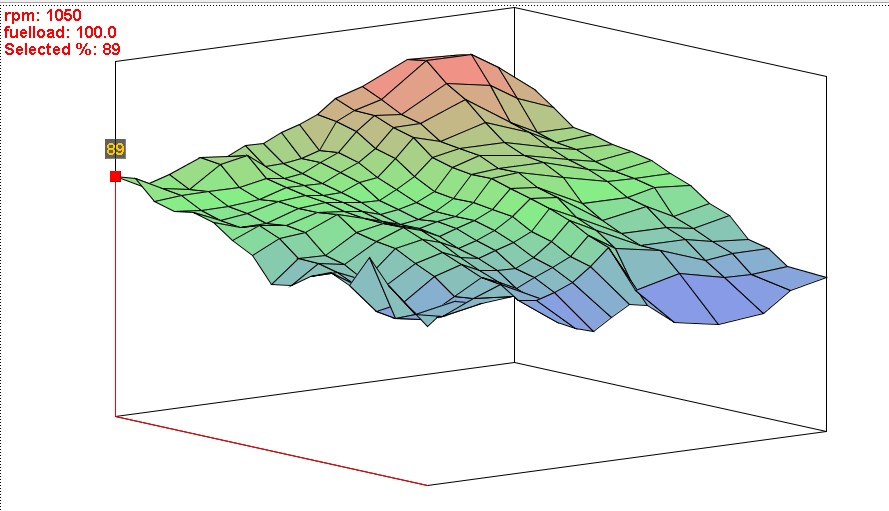
|
| bbrock |
 Nov 8 2021, 09:11 PM Nov 8 2021, 09:11 PM
Post
#32
|
|
914 Guru      Group: Members Posts: 5,269 Joined: 17-February 17 From: Montana Member No.: 20,845 Region Association: Rocky Mountains 
|
I'm learning (IMG:style_emoticons/default/piratenanner.gif)
In my noodling around trying to get a remedial grasp of this stuff, I saw a lot of example VE tables topping out well above 200 which is what led to my question about why not just use the AFR table. One youtuber who seemed to have a decent grasp of what he was doing simply explained it as a relative scale for adjusting injector PW. Plugging in actual VE numbers with a max of 100 makes more intuitive sense to me even if either way produces the same result. I also have been confused about stoich.settings. Of course "regular pump gas" these days is E10 which has a stoich of ~14.1 but all AFR examples I've seen are based on stoich = 14.7. Are they just assuming everyone runs pure gasoline? My stocker engine has 8:1 compression and runs just fine on 85/89 octane regular gas, so that's what I'll run most of the time. What's the proper setup and does what you use for stoich in the afr table matter if you are running closed loop with a wide band? |
| JamesM |
 Nov 8 2021, 10:10 PM Nov 8 2021, 10:10 PM
Post
#33
|
|
Advanced Member     Group: Members Posts: 2,103 Joined: 6-April 06 From: Kearns, UT Member No.: 5,834 Region Association: Intermountain Region |
Lol well I certainly done did it wrong, with many numbers exceeding 100 toward the top. But, as you describe, my "Required Fuel" was an initial WAG. It was based on TS' calculations from engine displacement and rated injector flow (Five-O 280cc injectors). I'm running a Bosch 3-bar pressure regulator. I don't see any value in changing it and re-doing the VE tables, unless that gives a knowledgeable tuner pause because he/she is working outside their comfort zone. I'd do it if I had to but I think I'd lose a lot of gain for where I am now. - GA I dont think you got it wrong, if you are running the A280H injectors I am guessing you have REQ_FUEL set correctly as flow info and deadtimes actually come documented with them. Also, interestingly enough, when I switched from using stock 2.0 injectors to the A280H with a 3 bar regulator I saw my peak VE numbers jump above 100 as well. Why? Not 100% sure but i would assume the difference between the two injector sets is that everyone (myself included) has always guessed at the actual deadtime and voltage correction settings for the 2.0 injectors and so they were most likely wrong and throwing off my whole table, this was one of the major reasons I went to the new injectors. Knowing the exact injector specs I can now kick on my headlights at idle and not have my mixture shift on me. The other reason why seeing numbers above 100 on the VE table makes sense is that 100 represents perfect efficiency IF we had the bin tuned at 14.7 AFR, but in those bins we are fueling to mid/low 12s which mathematically then looks like we are more efficient when in fact we are just running rich of stoch. We could do the math then if you wanted to know the "actual" engine VE, basically (Target AFR/14.7)*Table VE=Real VE So if you are seeing 105 VE in your table running at 12.3 AFR the pumping efficiency of the engine is really ~87% which is in the realm of believability for a mild performance cam. This of course assumes you don't have anything else factoring into the fuel equation at the time (like having turned on incorporate AFR targets) CAM, Intake, and exhaust all impact VE as well. |
| JamesM |
 Nov 8 2021, 10:28 PM Nov 8 2021, 10:28 PM
Post
#34
|
|
Advanced Member     Group: Members Posts: 2,103 Joined: 6-April 06 From: Kearns, UT Member No.: 5,834 Region Association: Intermountain Region |
Still working on this one, few things left to dial in Had some issues with the CAM sensor necessitating I pull the engine to adjust it but went in for knee surgery before I got it all done so now its waiting for me.
Testing the hard rev limiter here. I keep it on the conservative side at 6300 most of the time, but will bump that up on the day to 6500-6700 if the autox course demands it. I have reved this thing to 7k without realizing it before, hence the limiter As you can see its a pretty peaky and rev happy motor. comes on cam hard around 3800 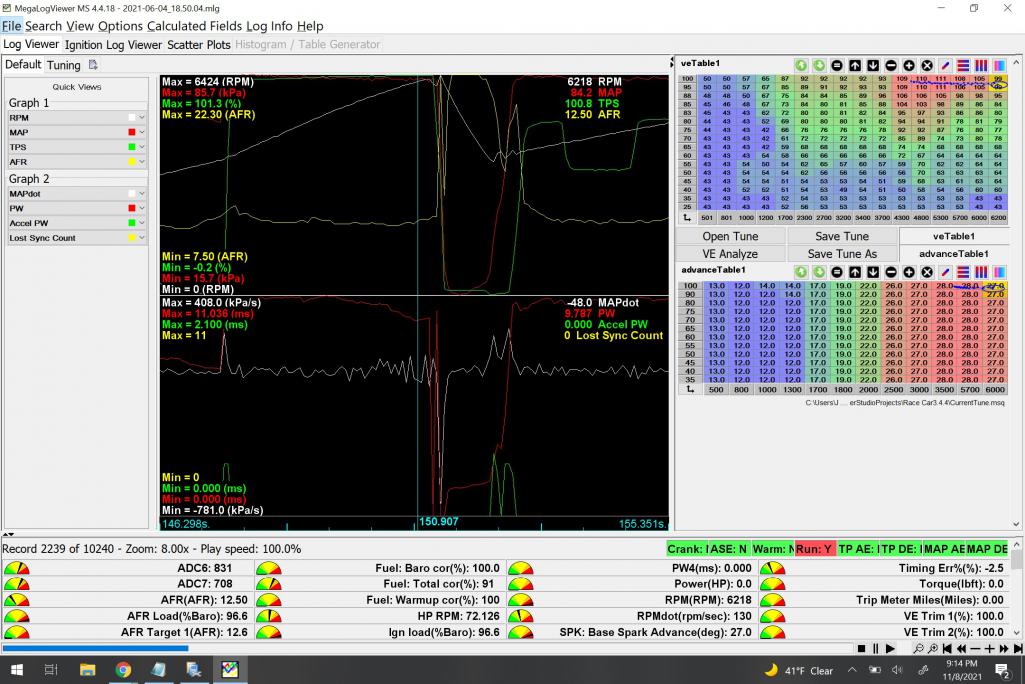 |
| JamesM |
 Nov 8 2021, 10:39 PM Nov 8 2021, 10:39 PM
Post
#35
|
|
Advanced Member     Group: Members Posts: 2,103 Joined: 6-April 06 From: Kearns, UT Member No.: 5,834 Region Association: Intermountain Region |
This probably also worth noting as i know we have had some discussion in other threads around injector selection
Max duty cycle i am seeing with the A280H injectors @3bar on my motor (CAM'd 2056 with headers) is still only about 52% @6000rpm. Granted I am at only 85% atmospheric pressure here in salt lake, down at sea level this would probably be a little higher, still lots of headroom on these injectors though. I swear ill get around to responding to the original posts on this thread at some point... 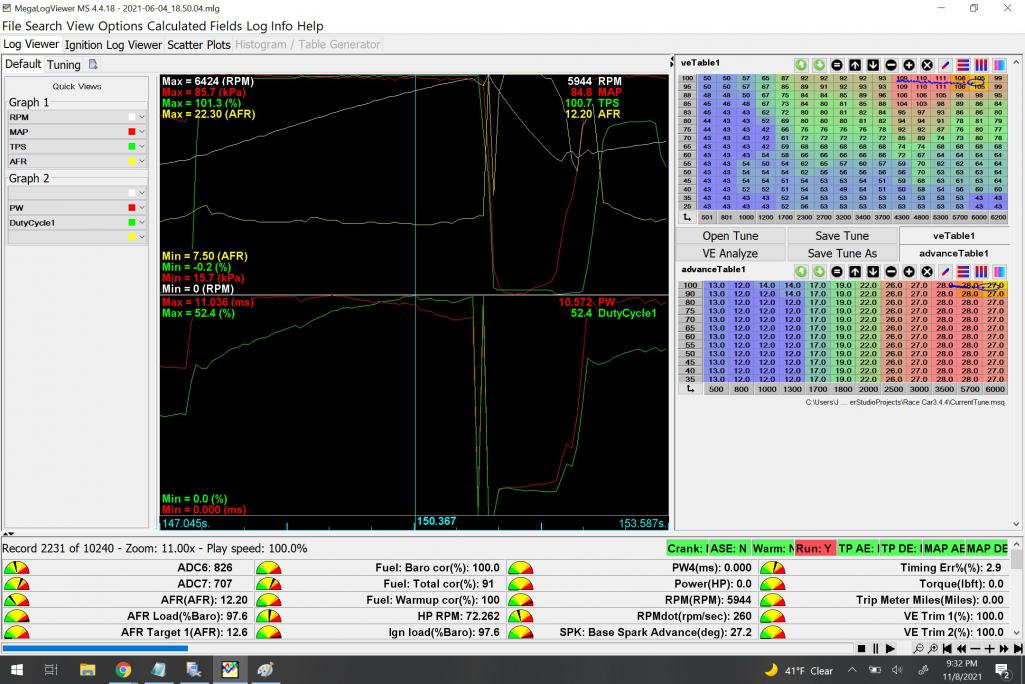 |
| JamesM |
 Nov 8 2021, 10:54 PM Nov 8 2021, 10:54 PM
Post
#36
|
|
Advanced Member     Group: Members Posts: 2,103 Joined: 6-April 06 From: Kearns, UT Member No.: 5,834 Region Association: Intermountain Region |
Anyone want more math exercises or for me to explain why you should be running the %barro fuel algorithm instead of straight Speed Density?
|
| JamesM |
 Nov 9 2021, 12:53 AM Nov 9 2021, 12:53 AM
Post
#37
|
|
Advanced Member     Group: Members Posts: 2,103 Joined: 6-April 06 From: Kearns, UT Member No.: 5,834 Region Association: Intermountain Region |
That equation makes perfect sense. I had to look up "GammaE," but I guess it's the combination of any other enrichment factors currently enabled, correct (e.g., warmup, accel enrichment, etc.)? So really ALL the AFR table is doing is changing the pulse width by the factor of dividing stoich (14.7 for pump gas) by the target AFR (e.g., 13.9). So in this example pulse width would be modified by a factor of 14.7/13.9, or roughly 1.05, all other enrichments being the same. Curious why you wouldn't use it? Is it because you are more comfortable with manipulating the VE table directly at this point? A few reasons im not really interested in it at the moment In my mind its just a feature that adds some simplicity by adding complexity and an additional factor to the fuel calculation. Also for it to make ANY sense your VE map has to be a dead on match to your target AFRs BEFORE enabling the feature, and for various reasons im not 100% sure I trust my O2 readings in all cases. I think some of the bigger issues for me is that once enabled your VE table is no longer an accurate representation of the fuel going into your motor as it has a factoring table then calculated on top of it. It prohibits you from editing you VE table directly without royally screwing things up, which then means you can no longer run autotune either. I dont necessarily have anything against the feature, but its a feature you only turn on once you have everything dialed in as far as hitting your AFR targets and then its only real use is experimenting with changes to AFRs. I already know what I want my target AFRs to be when im dialing in the VE table to hit them and even then, if I want to adjust them after the fact its not a big deal, so yeah, just not worth the effort to me. VE table is easy enough to use, you want more fuel in a specific area, increase the number, want less, decrease it, then take some datalogs and see where you are at. I could never trust a factor is going to get my fueling exactly where I want it so im going to be checking the logs either way. |
  |
1 User(s) are reading this topic (1 Guests and 0 Anonymous Users)
0 Members:

|
Lo-Fi Version | Time is now: 15th July 2025 - 02:06 AM |
Invision Power Board
v9.1.4 © 2025 IPS, Inc.








